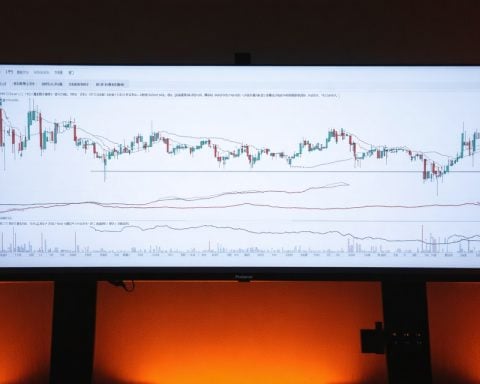The tech landscape is shifting dramatically as Nvidia’s stock takes a hit. The company’s shares dropped 5.2% to around $135.20, extending a 3.2% decline recorded on Friday. This decline has raised eyebrows following the unveiling of DeepSeek R1, a large-language model that claims to rival those from ChatGPT and Meta, operating on significantly lower budgets.
DeepSeek, backed by the Chinese quant fund High-Flyer, utilized approximately 50,000 of Nvidia’s H100 AI GPUs, which reflect last-generation technology. This development poses the possibility that other tech players might pursue leaner, more capital-efficient paths for AI innovation, potentially reducing the necessity for lavish spending on data centers and cutting-edge AI hardware.
According to analysts from Yardeni Research, while established tech companies may glean insights from DeepSeek to create cost-effective AI solutions, such a trend might not bode well for Nvidia’s future. Meanwhile, JPMorgan analysts believe concerns regarding increased AI expenditures are overstated, noting that DeepSeek’s efficiency stems largely from the stringent U.S. export controls placed on China’s semiconductor sector.
As six of Wall Street’s “Magnificent 7” firms, key clients of Nvidia, prepare to release their quarterly earnings this week, expectations are high for them to announce boosts in capital expenditure aimed at AI growth. Additionally, OpenAI recently revealed plans for a significant $500 billion investment into U.S. AI infrastructure, indicating that the race for AI supremacy is intensifying.
The Implications of AI’s Cost Efficiency Revolution
The recent decline in Nvidia’s stock underscores a pivotal moment in the tech industry, as the advent of more cost-efficient AI solutions could fundamentally alter the trajectory of investment and innovation. As companies turn to leaner models like DeepSeek R1, which operate on significantly lower budgets, the implications for society and the global economy are profound. The potential democratization of AI technology could lead to a surge in startups and smaller firms entering the AI space, fostering a culture of innovation driven by accessibility rather than exclusivity.
From an economic standpoint, a shift toward such efficiency may streamline capital flows in tech, redirecting investments away from traditional hardware giants toward agile software and service providers. This trend could disrupt existing market dynamics, creating a more competitive landscape where agility surpasses muscularity in hardware capabilities. As companies reassess their AI expenditures, there is potential for reduced operational costs across various sectors, ultimately benefiting consumers with enhanced products and services at lower prices.
However, the environmental implications of these shifts warrant scrutiny. The heavy reliance on costly data centers by past models has contributed to significant energy consumption and carbon footprints. Should the industry pivot to lower-cost, energy-efficient AI solutions, there may be notable reductions in environmental impact, aligning technological advancement with sustainability goals.
In the longer term, as firms increasingly prioritize cost efficiency and sustainability, we may witness a transformation that redefines the landscape of AI development, setting a precedent for future trends where innovation thrives in a circular economy framework.
Is the AI Race Shifting? Implications of Nvidia’s Stock Decline and DeepSeek’s Rise
As Nvidia experiences a notable stock drop, the tech landscape is witnessing significant shifts, particularly in the realm of artificial intelligence (AI). The decline in Nvidia’s shares by 5.2%, now hovering around $135.20, follows an earlier 3.2% fall. This raises concerns amid the rise of DeepSeek R1, an emerging language model that claims to compete directly with giants like ChatGPT and Meta, but with a markedly lower operational budget.
Key Features of DeepSeek R1
DeepSeek R1, developed by the Chinese quant fund High-Flyer, utilizes approximately 50,000 of Nvidia’s last-generation H100 AI GPUs. This efficiency raises questions about the future of AI innovation, suggesting that other tech firms might explore more capital-efficient methodologies, potentially leading to decreased reliance on expensive data center infrastructures and cutting-edge AI hardware.
Innovations and Use Cases
The launch of DeepSeek highlights a trend where the cost of developing AI technologies may become more sustainable, allowing smaller companies to innovate without incurring significant expenses. This could open doors to various applications, including:
– Natural Language Processing: Offering businesses alternatives to current language models at a fraction of the cost.
– Customer Service Solutions: Developing chatbots and virtual assistants that are more accessible for startups and small businesses.
– Data Analysis: Enabling enhanced data interpretation for companies hesitant to invest heavily in existing AI technologies.
Pros and Cons of the Current AI Landscape
Pros:
– Cost Efficiency: The ability to achieve competitive performance at lower costs allows more entities to enter the AI space.
– Diverse Innovation: A broader range of players may lead to more varied and innovative solutions.
– Increased Access: Smaller companies can capitalize on AI technologies that were previously accessible only to large enterprises.
Cons:
– Market Fragmentation: With numerous low-budget options, the market may become saturated, making it hard for any single solution to dominate.
– Quality Concerns: Cheaper models might not match the robustness and reliability of established players.
– Pressure on Established Companies: Firms like Nvidia may feel compelled to lower prices or invest heavily in marketing to maintain market share.
Market Insights and Predictions
Experts from Yardeni Research suggest that while established tech giants are learning to leverage cost-effective AI solutions, this trend may negatively impact Nvidia in the long run. However, analysts at JPMorgan argue that concerns surrounding increased AI spending in light of DeepSeek’s model efficiency may be exaggerated. They attribute much of DeepSeek’s success to stringent U.S. export controls limiting China’s access to advanced semiconductor technology.
Controversies and Limitations
DeepSeek’s emergence raises concerns regarding the global balance of AI power. The reliance on older technology could pose limitations in performance and capability compared to current leading models, potentially leading to controversies about competitiveness and quality among different AI providers. Moreover, ethical implications surrounding AI development and deployments remain at the forefront of discussions.
Conclusion and Future Outlook
As Nvidia braces for quarterly earnings reports from major clients known as Wall Street’s “Magnificent 7,” which may signal shifts in capital expenditures focused on AI, the competitive landscape for AI supremacy is rapidly evolving. OpenAI’s substantial $500 billion investment in U.S. AI infrastructure underscores the ongoing arms race in this sector.
Moving forward, companies must navigate the complexities introduced by innovations like DeepSeek while being acutely aware of the ethical, quality, and market dynamics involved in AI development. The tech landscape promises to be both challenging and thrilling in the upcoming years as the quest for AI leadership continues.
For more insights on technology and AI trends, visit TechCrunch.












